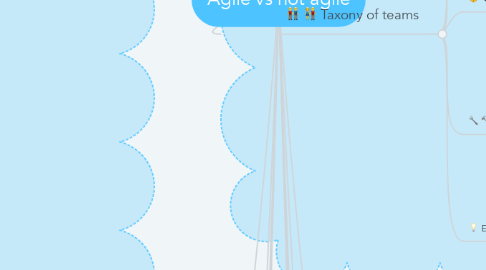
1. Customer experience teams
1.1. Decisions
1.2. Behaviour
1.3. Satisfaction
2. agile vs not agile
2.1. suit
2.1.1. innovation
2.1.1.1. products
2.1.1.2. services
2.1.1.3. processes
2.1.1.4. business models
2.1.2. departments
2.1.2.1. IT
2.1.2.2. HR
2.1.2.3. Product developement
2.1.2.4. Marketing
2.2. team
2.2.1. small
2.2.2. multidisciplinary
2.3. Work
2.3.1. dealing with problems
2.3.1.1. split task
2.3.1.2. prototyping
2.3.1.3. feedback
2.3.1.4. integrate
2.3.2. accountance
2.3.2.1. outcomes
2.3.2.1.1. growth
2.3.2.1.2. profitability
2.3.2.1.3. customer loyality
2.3.2.2. not outputs
2.3.2.2.1. lines of code
2.3.2.2.2. number of new products
2.3.3. leaders
2.3.3.1. chain-of-command bureaucracies
2.3.3.1.1. control
2.3.3.1.2. approval
2.3.3.1.3. top-down plans and directives
2.3.3.2. self-governing
2.3.3.2.1. where to innovate
2.3.3.2.2. how
2.3.3.3. leager coaches team members
2.4. Conditions
2.4.1. problems are complex
2.4.2. solutions are at first unclear
2.4.3. project requirements are likely to change
2.4.3.1. adapt to change
2.4.3.2. not stick a plan
2.4.4. close collaboration with end users is feasible
2.4.5. creative outperform command-and-control
2.4.6. Routine operations
2.5. Bosh example
2.5.1. 1. top-down management
2.5.2. 2. dual organization
2.5.2.1. hot new businesses run with agile teams
2.5.2.2. traditional functions left out of the action
2.5.3. 3.Felix Hieronymi
2.5.3.1. steering committee
2.5.3.2. software engineer - agile expert
2.5.4. 4. working committee
2.5.4.1. product owner
2.5.4.2. agile master
3. Building Agility
3.1. motivational system
3.1.1. training and coaching programm
3.1.2. revamp compensation system
3.2. special budget planning
3.2.1. avoiding annual planning
3.3. agile teams
3.3.1. face pressure from traditional departments
3.3.2. attack constraints during scaling
3.4. principles
3.4.1. integrating work streams
3.4.2. regular changes
3.4.3. modular approach
3.4.4. outsourcing is acceptable
3.4.5. consider feedback
3.4.6. close integration of agile teams
3.5. company
3.5.1. create
3.5.1.1. new principles
3.5.1.2. new values
3.5.2. change the culture
3.5.3. reduce control
4. Aim
4.1. teams
4.1.1. Small
4.1.2. Innovation
4.1.3. Enterpreneural
4.2. market
4.2.1. adapt cahging conditions
4.2.2. close to customers
4.3. result
4.3.1. team productivity
4.3.2. morale
4.3.3. faster time to market
4.3.4. better quality
4.3.5. lower risk
4.4. implementation
4.4.1. how many teams?
4.4.2. whole segment?
4.4.3. improve corporate performance as individual team performance?
4.5. companies
4.5.1. born agile
4.5.1.1. Spotify
4.5.1.2. Netflix
4.5.2. transform
4.5.2.1. Amazon
4.5.2.2. USAA
4.5.3. unsuccess
5. Collaboration
6. Business process teams
6.1. Relationships
6.2. Collaboration
6.3. Divided responsibilities
7. Behaviour
8. Taxony of teams
8.1. Customer experience teams
8.1.1. Decisions
8.1.2. Behaviour
8.1.3. Satisfaction
8.2. Business process teams
8.2.1. Relationships
8.2.2. Collaboration
8.2.3. Divided responsibilities
8.3. Technology systems teams
8.3.1. IT development
8.3.2. Support customers teams
8.4. Charachteristics
8.4.1. Encourages exploration
8.4.2. Helps spot constraints
8.4.3. Reveals talent gaps
8.4.4. Visible to everyone
8.5. Examples
9. Decisions
10. Relationships
11. Agile vs not agile
11.1. gh
11.1.1. gh
11.1.1.1. gh
11.1.1.1.1. gh
11.1.1.2. ghgh
11.1.2. ghjghj
11.2. Agile vs not agile
12. Aim
12.1. teams
12.1.1. Small
12.1.2. Innovation
12.1.3. Enterpreneural
12.2. market
12.2.1. adapt cahging conditions
12.2.2. close to customers
12.3. result
12.3.1. team productivity
12.3.2. morale
12.3.3. faster time to market
12.3.4. better quality
12.3.5. lower risk
12.4. implementation
12.4.1. how many teams?
12.4.2. whole segment?
12.4.3. improve corporate performance as individual team performance?
12.5. companies
12.5.1. born agile
12.5.1.1. Spotify
12.5.1.2. Netflix
12.5.2. transform
12.5.2.1. Amazon
12.5.2.2. USAA
12.5.3. unsuccess
